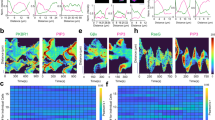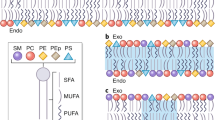Abstract
The plasma membrane is made up of lipids and proteins, and serves as an active interface between the cell and its environment. Many plasma-membrane proteins are laterally segregated in the plane of the membrane, but the underlying mechanisms remain controversial. Here we investigate the distribution and dynamics of a representative set of plasma-membrane-associated proteins in yeast cells. These proteins were distributed non-homogeneously in patterns ranging from distinct patches to nearly continuous networks, and these patterns were in turn strongly influenced by the lipid composition of the plasma membrane. Most proteins segregated into distinct domains. However, proteins with similar or identical transmembrane sequences (TMSs) showed a marked tendency to co-localize. Indeed we could predictably relocate proteins by swapping their TMSs. Finally, we found that the domain association of plasma-membrane proteins has an impact on their function. Our results are consistent with self-organization of biological membranes into a patchwork of coexisting domains.
This is a preview of subscription content, access via your institution
Access options
Subscribe to this journal
Receive 12 print issues and online access
$209.00 per year
only $17.42 per issue
Buy this article
- Purchase on Springer Link
- Instant access to full article PDF
Prices may be subject to local taxes which are calculated during checkout








Similar content being viewed by others
References
Berchtold, D. & Walther, T. C. TORC2 plasma membrane localization is essential for cell viability and restricted to a distinct domain. Mol. Biol. Cell 20, 1565–1575 (2009).
Sharma, P. et al. Nanoscale organization of multiple GPI-anchored proteins in living cell membranes. Cell 116, 577–589 (2004).
Bagatolli, L. A., Ipsen, J. H., Simonsen, A. C. & Mouritsen, O. G. An outlook on organization of lipids in membranes: searching for a realistic connection with the organization of biological membranes. Prog Lipid Res. 49, 378–389 (2010).
Lingwood, D., Kaiser, H. J., Levental, I. & Simons, K. Lipid rafts as functional heterogeneity in cell membranes. Biochem. Soc. Trans. 37, 955–960 (2009).
Douglass, A. D. & Vale, R. D. Single-molecule microscopy reveals plasma membrane microdomains created by protein–protein networks that exclude or trap signaling molecules in T cells. Cell 121, 937–950 (2005).
Kusumi, A., Sako, Y. & Yamamoto, M. Confined lateral diffusion of membrane receptors as studied by single particle tracking (nanovid microscopy). Effects of calcium-induced differentiation in cultured epithelial cells. Biophys. J. 65, 2021–2040 (1993).
Sackmann, E., Lipowsky, R. & Sackmann, E. Handbook of Biological Physics Vol. 1, Part 1, 1–63 (North-Holland, 1995).
Anderson, R. G. & Jacobson, K. A role for lipid shells in targeting proteins to caveolae, rafts, and other lipid domains. Science 296, 1821–1825 (2002).
Malı´nská, K., Malı´nská, J., Opekarová, M. & Tanner, W. Visualization of protein compartmentation within the plasma membrane of living yeast cells. Mol. Biol. Cell 14, 4427–4436 (2003).
Kaksonen, M., Toret, C. P. & Drubin, D. G. A modular design for the clathrin- and actin-mediated endocytosis machinery. Cell 123, 305–320 (2005).
Yu, J. H., Crevenna, A. H., Bettenbuhl, M., Freisinger, T. & Wedlich-Soldner, R. Cortical actin dynamics driven by formins and myosin V. J. Cell Sci. 124, 1533–1541 (2011).
Walther, T. C. et al. Eisosomes mark static sites of endocytosis. Nature 439, 998–1003 (2006).
Fiolka, R., Beck, M. & Stemmer, A. Structured illumination in total internal reflection fluorescence microscopy using a spatial light modulator. Opt. Lett. 33, 1629–1631 (2008).
Stauffer, T. P., Ahn, S. & Meyer, T. Receptor-induced transient reduction in plasma membrane PtdIns(4,5)P2 concentration monitored in living cells. Curr. Biol. 8, 343–346 (1998).
Yeung, T. et al. Membrane phosphatidylserine regulates surface charge and protein localization. Science 319, 210–213 (2008).
Grossmann, G. et al. Plasma membrane microdomains regulate turnover of transport proteins in yeast. J. Cell Biol. 183, 1075–1088 (2008).
Ghaemmaghami, S. et al. Global analysis of protein expression in yeast. Nature 425, 737–741 (2003).
Goswami, D. et al. Nanoclusters of GPI-anchored proteins are formed by cortical actin-driven activity. Cell 135, 1085–1097 (2008).
Greenberg, M. L. & Axelrod, D. Anomalously slow mobility of fluorescent lipid probes in the plasma membrane of the yeast Saccharomyces cerevisiae. J. Membr. Biol. 131, 115–127 (1993).
Valdez-Taubas, J. & Pelham, H. R. B. Slow diffusion of proteins in the yeast plasma membrane allows polarity to be maintained by endocytic cycling. Curr. Biol. 13, 1636–1640 (2003).
Marco, E., Wedlich-Soldner, R., Li, R., Altschuler, S. J. & Wu, L. F. Endocytosis optimizes the dynamic localization of membrane proteins that regulate cortical polarity. Cell 129, 411–422 (2007).
Manders, E. M. M., Verbeek, F. J. & Aten, J. A. Measurement of co-localization of object in dual-colour confocal images. J. Microsc. 169, 375–382 (1993).
Malinska, K., Malinsky, J., Opekarova, M. & Tanner, W. Distribution of Can1p into stable domains reflects lateral protein segregation within the plasma membrane of living S. cerevisiae cells. J. Cell Sci. 117, 6031–6041 (2004).
Flegelova, H. & Sychrova, H. Mammalian NHE2 Na(+)/H+ exchanger mediates efflux of potassium upon heterologous expression in yeast. FEBS Lett. 579, 4733–4738 (2005).
Tarassov, K. et al. An in vivo map of the yeast protein interactome. Science 320, 1465–1470 (2008).
Momoi, M. et al. SLI1 (YGR212W) is a major gene conferring resistance to the sphingolipid biosynthesis inhibitor ISP-1, and encodes an ISP-1 N-acetyltransferase in yeast. Biochem. J. 381, 321–328 (2004).
Hikiji, T., Miura, K., Kiyono, K., Shibuya, I. & Ohta, A. Disruption of the CHO1 gene encoding phosphatidylserine synthase in Saccharomyces cerevisiae. J. Biochem. 104, 894–900 (1988).
Heese-Peck, A. et al. Multiple functions of sterols in yeast endocytosis. Mol. Biol. Cell 13, 2664–2680 (2002).
Davierwala, A. P. et al. The synthetic genetic interaction spectrum of essential genes. Nat. Genet. 37, 1147–1152 (2005).
Opekarova, M., Caspari, T. & Tanner, W. Unidirectional arginine transport in reconstituted plasma-membrane vesicles from yeast overexpressing CAN1. Eur. J. Biochem. 211, 683–688 (1993).
Rothbauer, U. et al. Targeting and tracing antigens in live cells with fluorescent nanobodies. Nat. Methods 3, 887–889 (2006).
Walther, T. C. et al. Eisosomes mark static sites of endocytosis. Nature 439, 998–1003 (2006).
Frohlich, F. et al. A genome-wide screen for genes affecting eisosomes reveals Nce102 function in sphingolipid signaling. J. Cell Biol. 185, 1227–1242 (2009).
Engelman, D. M. Membranes are more mosaic than fluid. Nature 438, 578–580 (2005).
Ejsing, C. S. et al. Global analysis of the yeast lipidome by quantitative shotgun mass spectrometry. Proc. Natl Acad. Sci. USA 106, 2136–2141 (2009).
Sharpe, H. J., Stevens, T. J. & Munro, S. A comprehensive comparison of transmembrane domains reveals organelle-specific properties. Cell 142, 158–169 (2010).
Gallego, O. et al. A systematic screen for protein–lipid interactions in Saccharomyces cerevisiae. Mol. Syst. Biol. 6, 430 (2010).
Hite, R. K., Li, Z. & Walz, T. Principles of membrane protein interactions with annular lipids deduced from aquaporin-0 2D crystals. EMBO J. 29, 1652–1658 (2010).
Lehtonen, J. Y., Holopainen, J. M. & Kinnunen, P. K. Evidence for the formation of microdomains in liquid crystalline large unilamellar vesicles caused by hydrophobic mismatch of the constituent phospholipids. Biophys. J. 70, 1753–1760 (1996).
Thomas, C. L., Bayer, E. M., Ritzenthaler, C., Fernandez-Calvino, L. & Maule, A. J. Specific targeting of a plasmodesmal protein affecting cell-to-cell communication. PLoS Biol. 6, e7 (2008).
Day, C. A. & Kenworthy, A. K. Tracking microdomain dynamics in cell membranes. Biochim. Biophys. Acta 1788, 245–253 (2009).
Fan, J., Sammalkorpi, M. & Haataja, M. Formation and regulation of lipid microdomains in cell membranes: theory, modeling, and speculation. FEBS Lett. 584, 1678–1684 (2010).
Bagnat, M. & Simons, K. Cell surface polarization during yeast mating. Proc. Natl Acad. Sci. USA 99, 14183–14188 (2002).
Tyteca, D. et al. Three unrelated sphingomyelin analogs spontaneously cluster into plasma membrane micrometric domains. Biochim. Biophys. Acta 1798, 909–927 (2010).
Lauwers, E. & André, B. Association of yeast transporters with detergent-resistant membranes correlates with their cell-surface location. Traffic 7, 1045–1059 (2006).
Opekarova, M., Malinska, K., Novakova, L. & Tanner, W. Differential effect of phosphatidylethanolamine depletion on raft proteins: further evidence for diversity of rafts in Saccharomyces cerevisiae. Biochim. Biophys. Acta 1711, 87–95 (2005).
Janke, C. et al. A versatile toolbox for PCR-based tagging of yeast genes: new fluorescent proteins, more markers and promoter substitution cassettes. Yeast 21, 947–962 (2004).
Huh, W-K. et al. Global analysis of protein localization in budding yeast. Nature 425, 686–691 (2003).
George, N., Pick, H., Vogel, H., Johnsson, N. & Johnsson, K. Specific labeling of cell surface proteins with chemically diverse compounds. J. Am. Chem. Soc. 126, 8896–8897 (2004).
Hirvonen, L. M., Wicker, K., Mandula, O. & Heintzmann, R. Structured illumination microscopy of a living cell. Eur. Biophys. J. 38, 807–812 (2009).
Acknowledgements
We are indebted to A. Rohrbach for providing access to the TIRF-SIM microscope and analysis. We thank N. Johnsson (Institute for Molecular Genetics and Cell Biology, Ulm University, Germany) for providing the plasmid ACP–Sag1 and P. Hardy for editorial assistance. This work was financially supported by the Max Planck Society.
Author information
Authors and Affiliations
Contributions
R.W-S., F.S. and N.S.M. designed all experiments. F.S. performed all microscopy and experiments with help from G.B. N.S.M., F.S., J.B. and R.W-S. analysed the data. P.v.O. and F.S. performed the TIRF-SIM experiments. F.S., N.S.M. and R.W-S. wrote the paper.
Corresponding author
Ethics declarations
Competing interests
The authors declare no competing financial interests.
Supplementary information
Supplementary Information
Supplementary Information (PDF 1137 kb)
Supplementary Table 2
Supplementary Information (PDF 6562 kb)
Supplementary Table 1
Supplementary Information (XLS 39 kb)
Supplementary Table 3
Supplementary Information (XLS 10 kb)
Supplementary Table 4
Supplementary Information (XLS 20 kb)
Supplementary Table 5
Supplementary Information (XLS 35 kb)
Supplementary Table 6
Supplementary Information (XLS 26 kb)
Supplementary Table 7
Supplementary Information (XLS 17 kb)
Supplementary Table 8
Supplementary Information (XLS 24 kb)
Supplementary Table 9
Supplementary Information (XLS 29 kb)
Supplementary Movie 1
Supplementary Information (MOV 1074 kb)
Supplementary Movie 2
Supplementary Information (MOV 3121 kb)
Supplementary Movie 3
Supplementary Information (MOV 1765 kb)
Supplementary Movie 4
Supplementary Information (MOV 4619 kb)
Supplementary Movie 5
Supplementary Information (MOV 1387 kb)
Rights and permissions
About this article
Cite this article
Spira, F., Mueller, N., Beck, G. et al. Patchwork organization of the yeast plasma membrane into numerous coexisting domains. Nat Cell Biol 14, 640–648 (2012). https://doi.org/10.1038/ncb2487
Received:
Accepted:
Published:
Issue Date:
DOI: https://doi.org/10.1038/ncb2487
This article is cited by
-
Structure and activation mechanism of the hexameric plasma membrane H+-ATPase
Nature Communications (2021)
-
Steric exclusion and protein conformation determine the localization of plasma membrane transporters
Nature Communications (2018)
-
Emerging roles for sphingolipids in cellular aging
Current Genetics (2018)
-
Alteration of interleaflet coupling due to compounds displaying rapid translocation in lipid membranes
Scientific Reports (2016)
-
Plasma membrane organization promotes virulence of the human fungal pathogen Candida albicans
Journal of Microbiology (2016)



